Effect of Sinkholes on Groundwater Resources in Arid and Semi-Arid Karst Area in Abarkooh, Iran
Abstract
1. Introduction
2. Materials and Methods
2.1. Methodology
2.2. Study Area with Geological, Hydrogeological and Meteorological Characteristics
3. Artificial Recharge and Chemical Constituents in Sampled Surface Water
4. Bedrock Fractures and Thickness of Surface Cover
5. Vulnerable Areas for Future Sinkholes
6. Conclusions and Recommendations
- 1—Reducing the occurrence of sinkholes in the region and mapping of critical areas of risk and prevention of environmental pollution;
- 2—Any artificial recharge operation and creation of embankments and basin should be stopped;
- 3—Changing the regional pattern of flood irrigation to the drip method and controlling the exploitation to prevent the infiltration and concentration of water into farms;
- 4—Application of geophysical methods and the use of ground penetrating radar (GPR), electromagnetic geophysical survey (EMS) and seismic gravimetric methods order to identify the critical areas;
- 5—Prevention of waste dumping in sinkholes;
- 6—Groundwaterflow tracing from the location of the sinkholes to determine the relationships between groundwater flow and its effect on the exploitation wells;
- 7—Prevention from digging the wells and drilling in critical areas;
- 8—Wells that have higher discharge and have entered the bedrock should be controlled or shut down.
Author Contributions
Funding
Acknowledgments
Conflicts of Interest
References
- United States Geological Survey (USGS). Available online: https://www.usgs.gov/faqs/what-are-sinkholes?qt-news_science_products=0#qt-news_science_products (accessed on 3 January 2018).
- Waltham, A.C.; Fookes, P.G. Engineering classification of karst ground conditions. Q. J. Eng. Geol. Hydrogeol. 2003, 36, 101–118. [Google Scholar] [CrossRef]
- Masciopinto, C.; De Giglio, O.; Scrascia, M.; Fortunato, F.; La Rosa, G.; Suffredini, E.; Pazzani, C.; Prato, R.; Montagna, M.T. Human health risk assessment for the occurrence of enteric viruses in drinking water from wells: Role of flood runoff injections. Sci. Tot. Environ. 2019, 666, 559–571. [Google Scholar] [CrossRef] [PubMed]
- Ford, D.C.; Williams, P.W. Karst Geomorphology and Hydrology; Springer: London, UK, 1989; p. 601. [Google Scholar]
- Barry, F.; Beck, A.J. Hydrogeology and Engineering Geology of Sinkholes and Karst; Balkema: Rotterdam, The Netherlands, 1999. [Google Scholar]
- Beck, B.F. Sinkholes and the Engineering and Environmental Impacts of Karst; The American Society of Civil Engineers: San Antonio, TX, USA, 2005. [Google Scholar]
- Naseri, H.R. Hydrogeological Study of Karst Springs of Durudzan dam Catchment Area. Master’s Thesis, Shiraz University, Shiraz, Iran, 1991; p. 315. [Google Scholar]
- Khanlari, G.R.; Heidari, M.; Momeni, A.A.; Ahmadi, M.; Taleb-Beydokhti, A. The effect of groundwater over exploitation on land subsidence and sinkhole occurrences, Western Iran. Q. J. Eng. Geol. Hydrogeol. Iran 2012, 45, 447–456. [Google Scholar] [CrossRef]
- Karimi, H.; Taheri, K. Hazards and mechanism of sinkholes on Kabudar Ahang and Famenin plains of Hamadan, Iran. Nat. Hazards 2010, 55, 481–499. [Google Scholar] [CrossRef]
- Belfar, D.; Fehdi, C.; Baali, F.; Salameh, E. Results of a hydrogeological and hydrogeochemical study of a semi-arid karst aquifer in Tezbent plateau, Tebessa region, northeast of Algeria. Appl. Water Sci. 2017, 7, 1099–1105. [Google Scholar] [CrossRef]
- Gillieson, D.S.; Cochrane, J.A.; Murray, A. Surface hydrology and soil movement in an arid karst: The Nullarbor Plain, Australia. Environ. Geol. 1994, 23, 125–133. [Google Scholar] [CrossRef]
- Ahmad Dar, F.; Perrin, J.; Riotte, J.; Daniel Gebauer, H.; Chinna Narayana, A.; Ahmed, S. Karstification in the Cuddapah Sedimentary Basin, Southern India: Implications for Groundwater Resources. Acta Carsologica 2011, 40, 3. [Google Scholar]
- Zheng, X.; Zang, H.; Zhang, Y.; Chen, J.; Zhang, F.; Shen, Y. A Study of Hydrogeochemical Processes on Karst Groundwater Using a Mass Balance Model in the Liulin Spring Area, North China. Water 2018, 10, 903. [Google Scholar] [CrossRef]
- Yousif, M.; Oguchi, T.; Anazawa, K.; Takeshi, O. Framework for Investigation of Karst Aquifer in an Arid Zone, Using Isotopes, Remote Sensing and GIS Applications: The Northwestern Coast of Egypt. Environ. Process 2015, 2, 37–60. [Google Scholar] [CrossRef]
- Karimi Vardanjani, H.; Chitsazan, M.; Ford, D.; Karimi, H.; Charchi, A. Initial assessment of recharge areas for large karst springs: A case study from the central Zagros Mountains, Iran. Hydrogeol. J. 2018, 26, 57–70. [Google Scholar] [CrossRef]
- Pazand, K.; Khosravi, D.; Ghaderi, M.R.; Rezvanianzadeh, M.R. Identification of the hydrogeochemical processes and assessment of groundwater in a semi-arid region using major ion chemistry: A case study of Ardestan basin in Central Iran. Groundw. Sustain. Dev. 2018, 6, 245–254. [Google Scholar] [CrossRef]
- Xanke, J. Managed Aquifer Recharge into a Karst Groundwater System at the Wala Reservoir, Jordan. Ph.D. Thesis, Karlsruher Institute fur Technologie, Karlsruhe, Germany, 2017. [Google Scholar]
- Taheri, K.; Gutiérrez, F.; Mohseni, H.; Raeisi, E.; Taheri, M. Sinkhole susceptibility mapping using the analytical hierarchy process (AHP) and magnitude–frequency relationships: A case study in Hamadan province, Iran. Geomorphology 2015, 234, 64–79. [Google Scholar] [CrossRef]
- Taheri, K.; Shahabi, H.; Chapi, K.; Shirzadi, A.; Gutiérrez, F.; Khosravi, K. Sinkhole susceptibility mapping: A comparison between Bayes-based machine learning algorithms. Land Degrad. Dev. 2019, 37, 730–745. [Google Scholar] [CrossRef]
- Perrin, J.; Cartannaz, C.; Noury, G.; Vanoudheusden, E. A multicriteria approach to karst subsidence hazard mapping supported by weights-of-evidence analysis. Eng. Geol. 2015, 197, 296–305. [Google Scholar] [CrossRef]
- Mahmoudi Sivand, S. Yazd Province Authority. Meteorological Data; Iran karst research center: Shiraz, Iran, 2011. [Google Scholar]
- Google Maps. Available online: www.google.com (accessed on 2 February 2020).
- Mahmoudi Sivand, S. Official report about hydrogeological, hydrogeochemistry and geophysical investigation at Feizabad site. Available online: www.yzrw.ir (accessed on 1 August 2016).
- Waltham, F.B. Sinkholes and Subsidence, Karst and Cavernous Rocks in Engineering and Construction; Praxis Publishing: Chichester, UK, 2005. [Google Scholar]
- United States Environmental Protection Agency [US EPA]. 2018 Edition of the Drinking Water Standards and Health Advisories Tables. Available online: www.epa.gov (accessed on 5 March 2018).


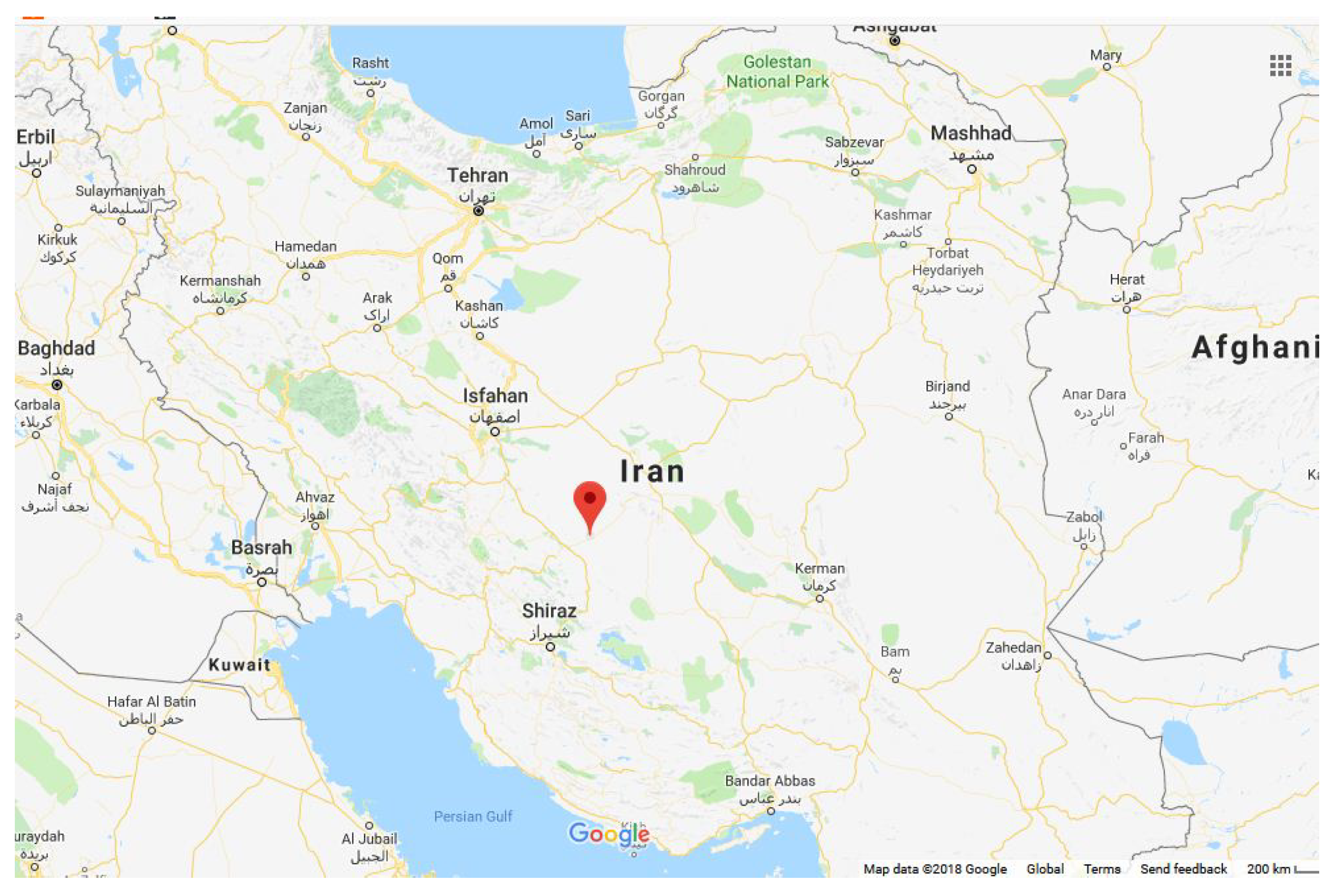
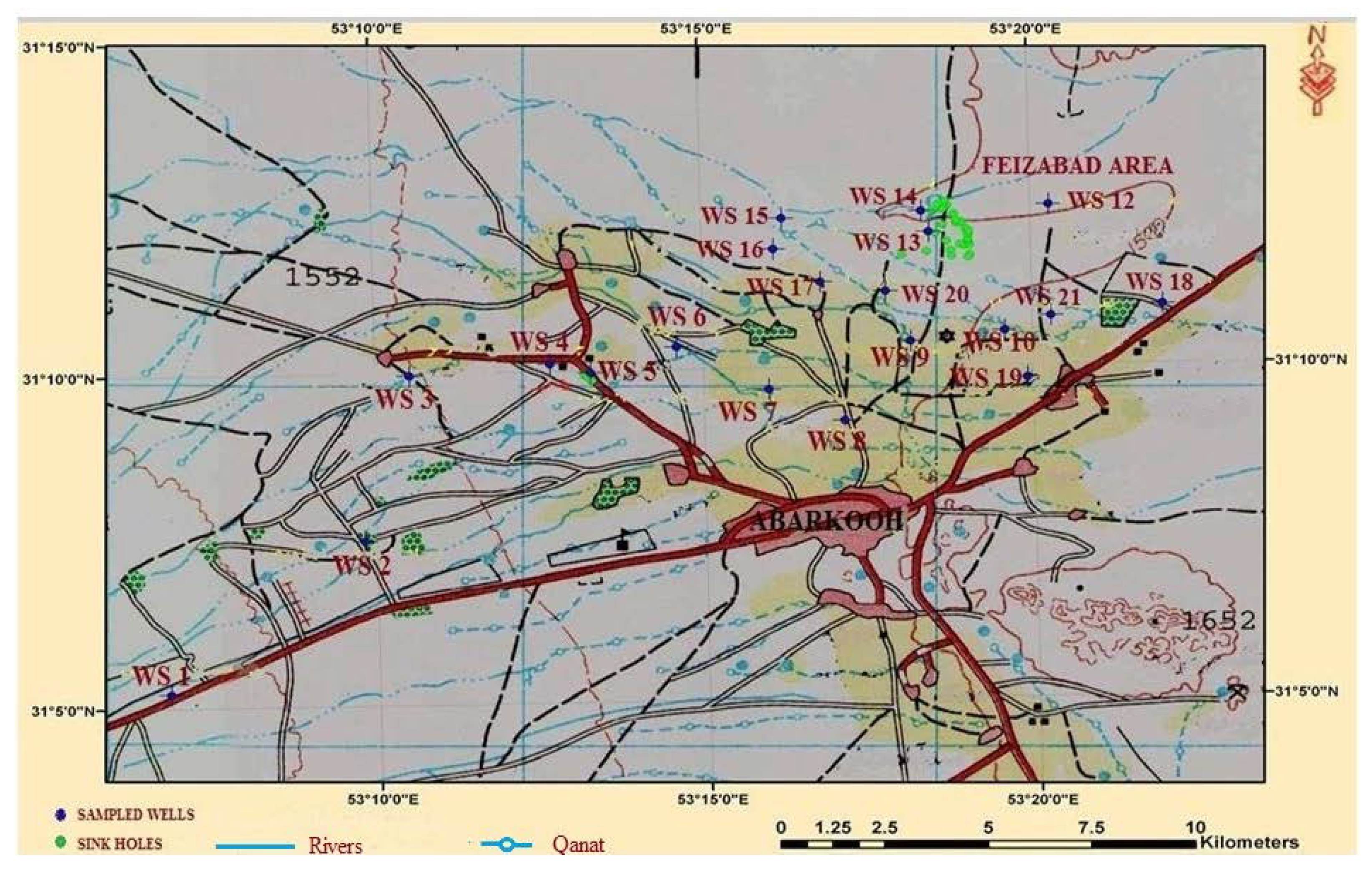
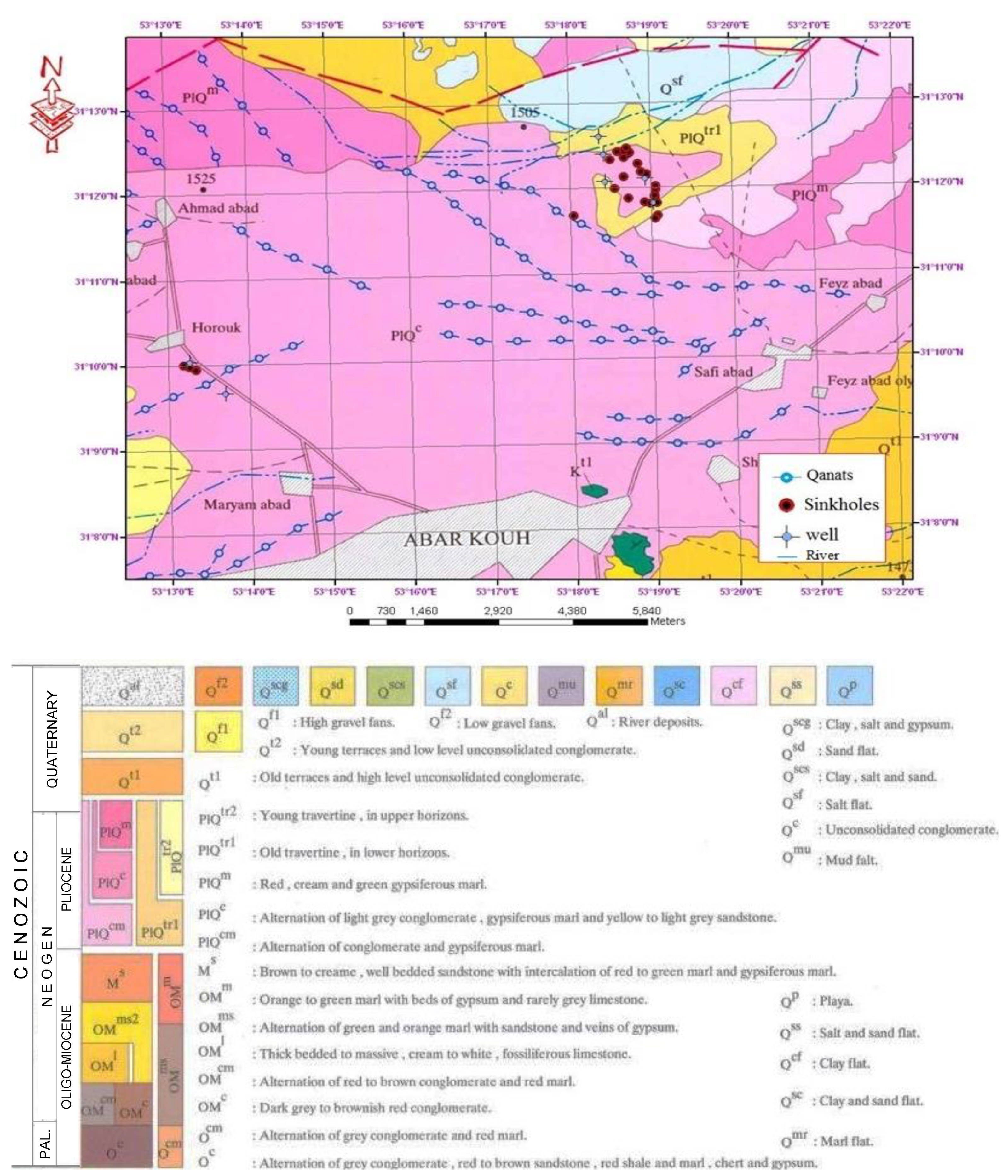
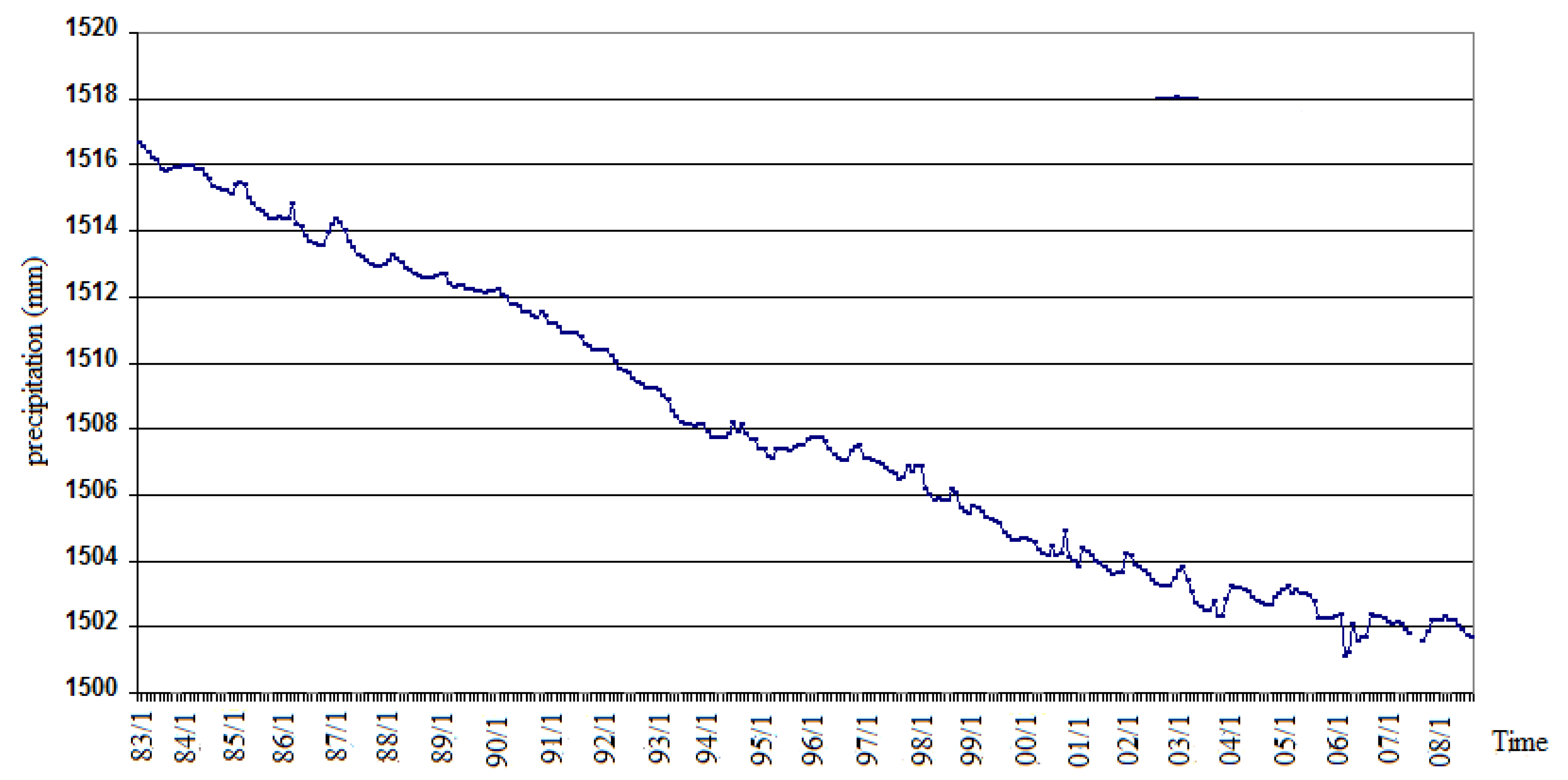
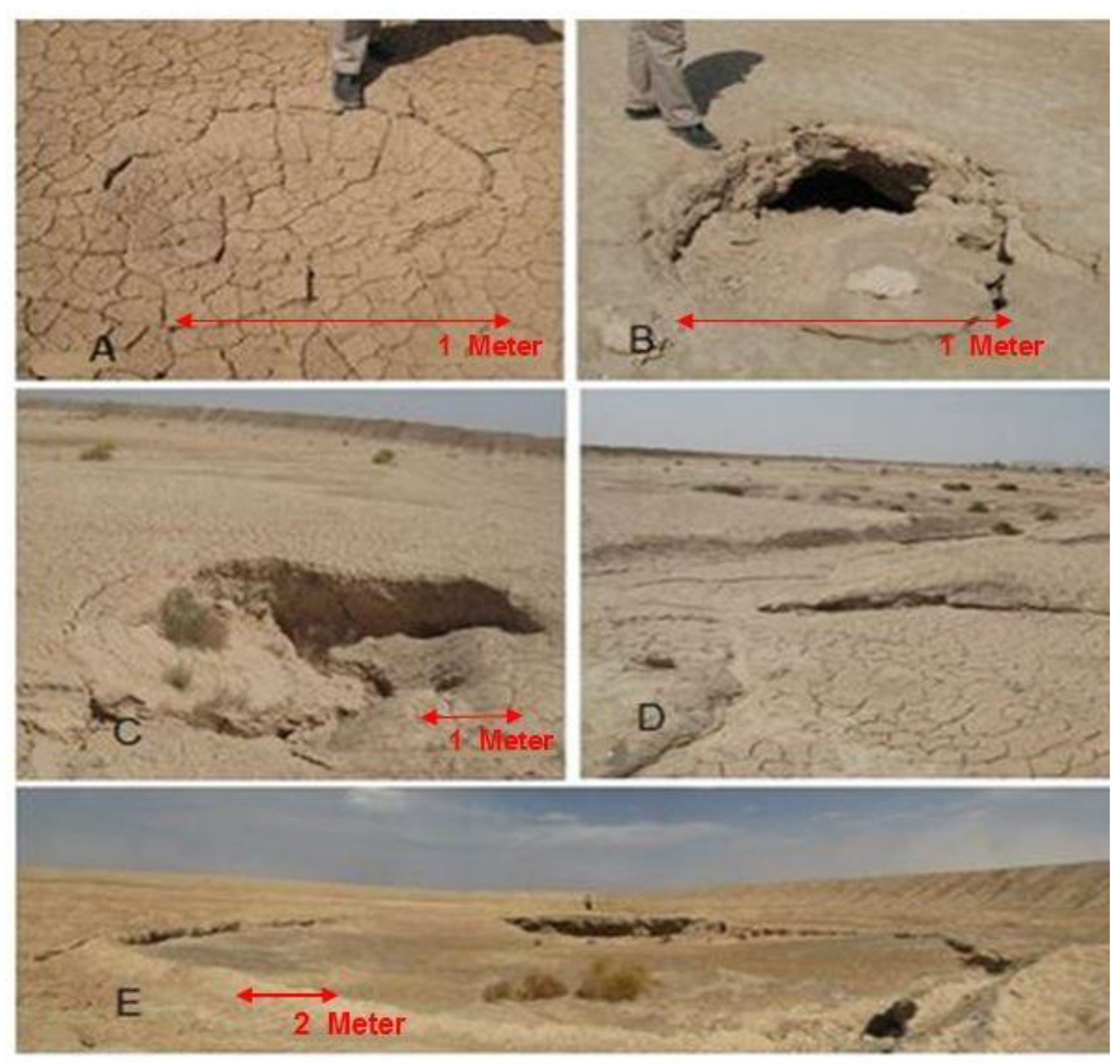
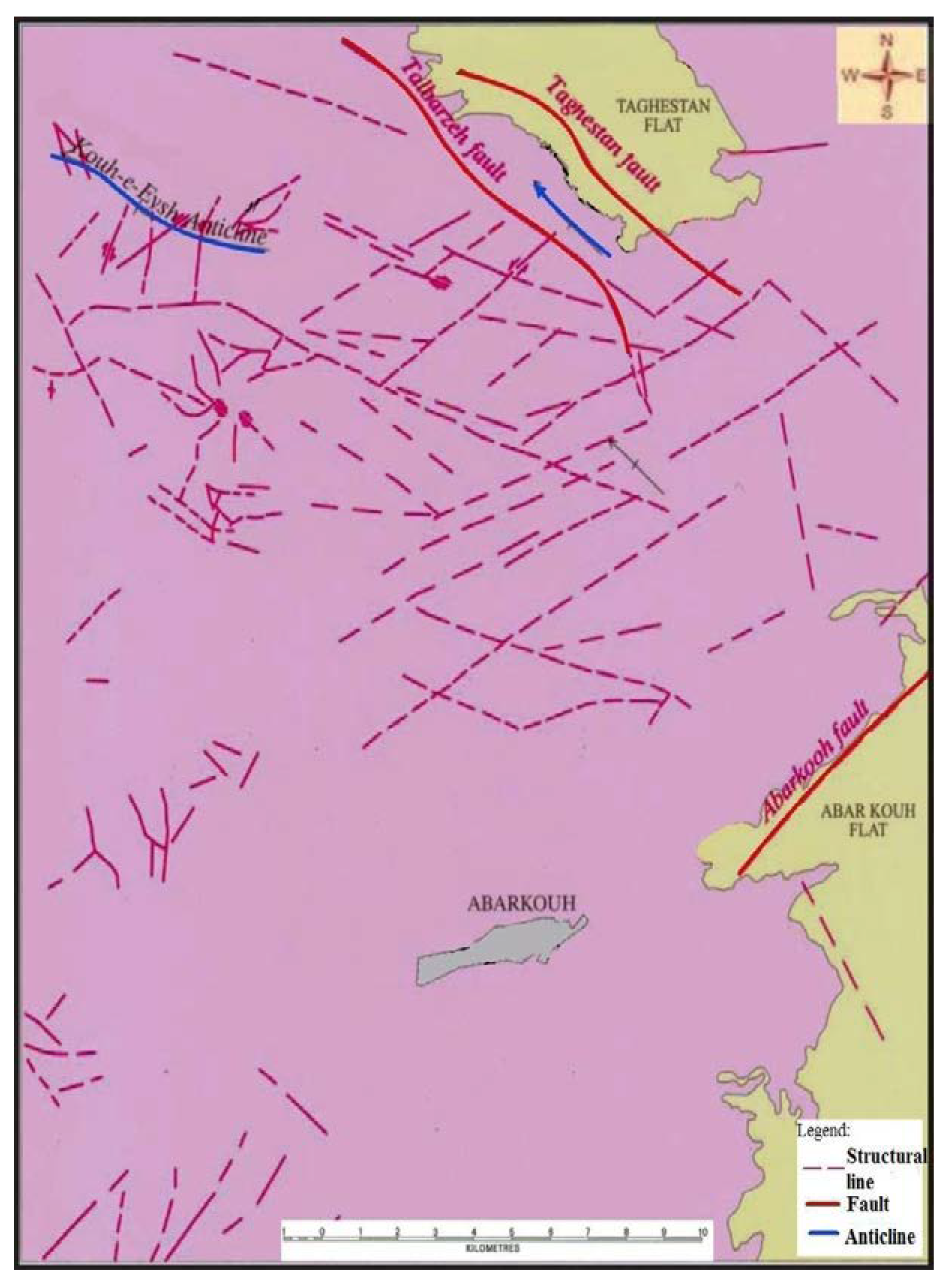
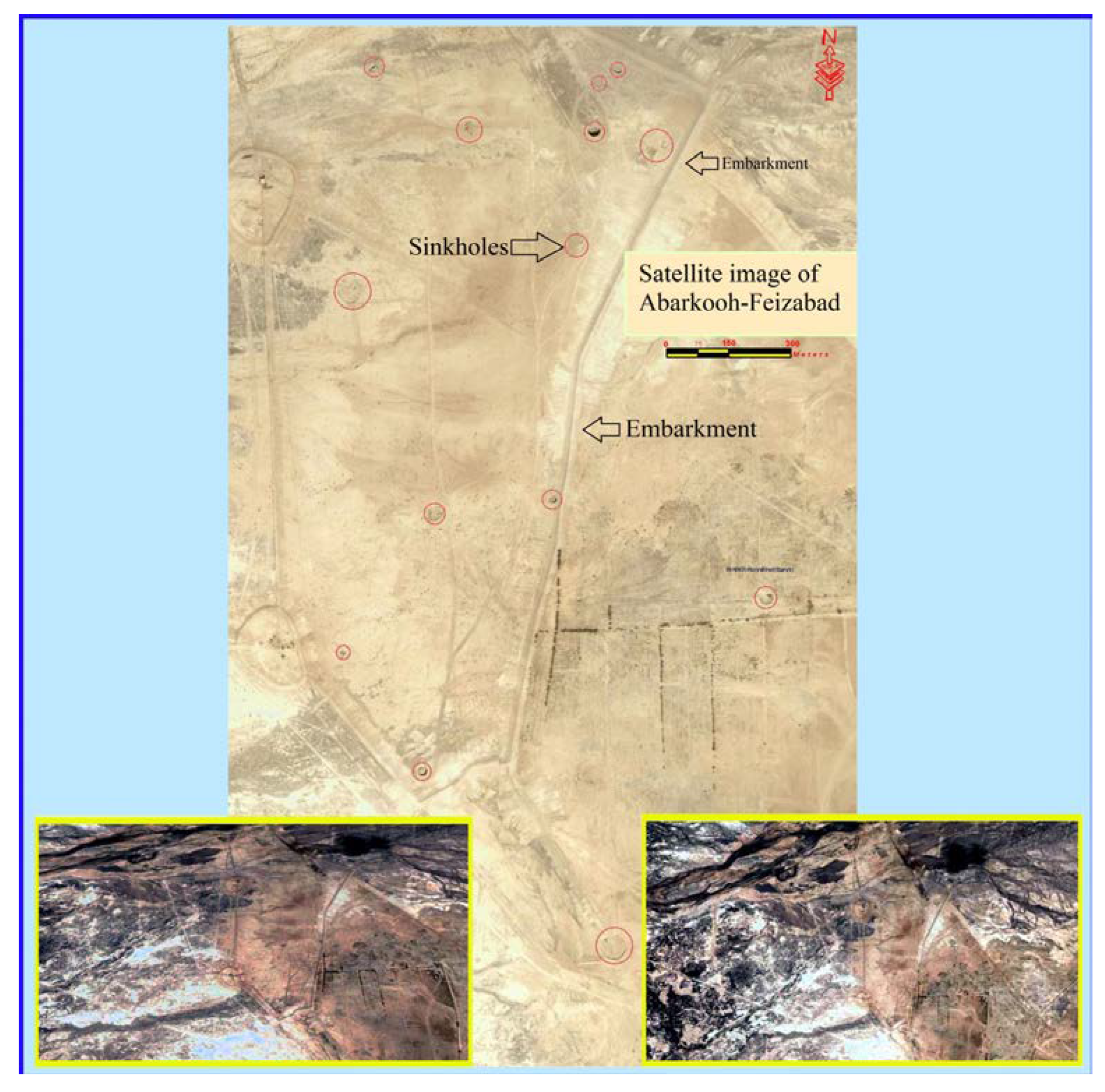
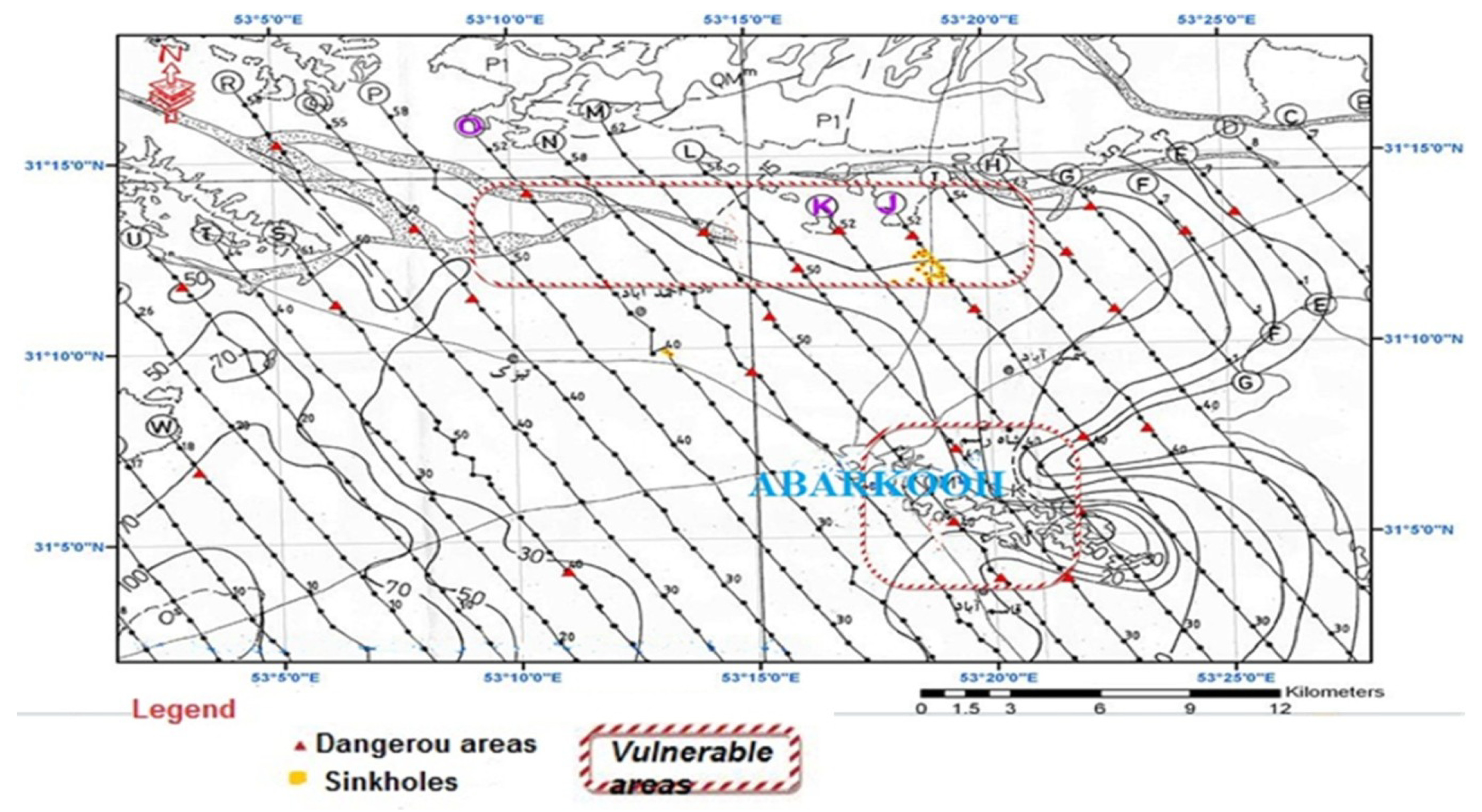
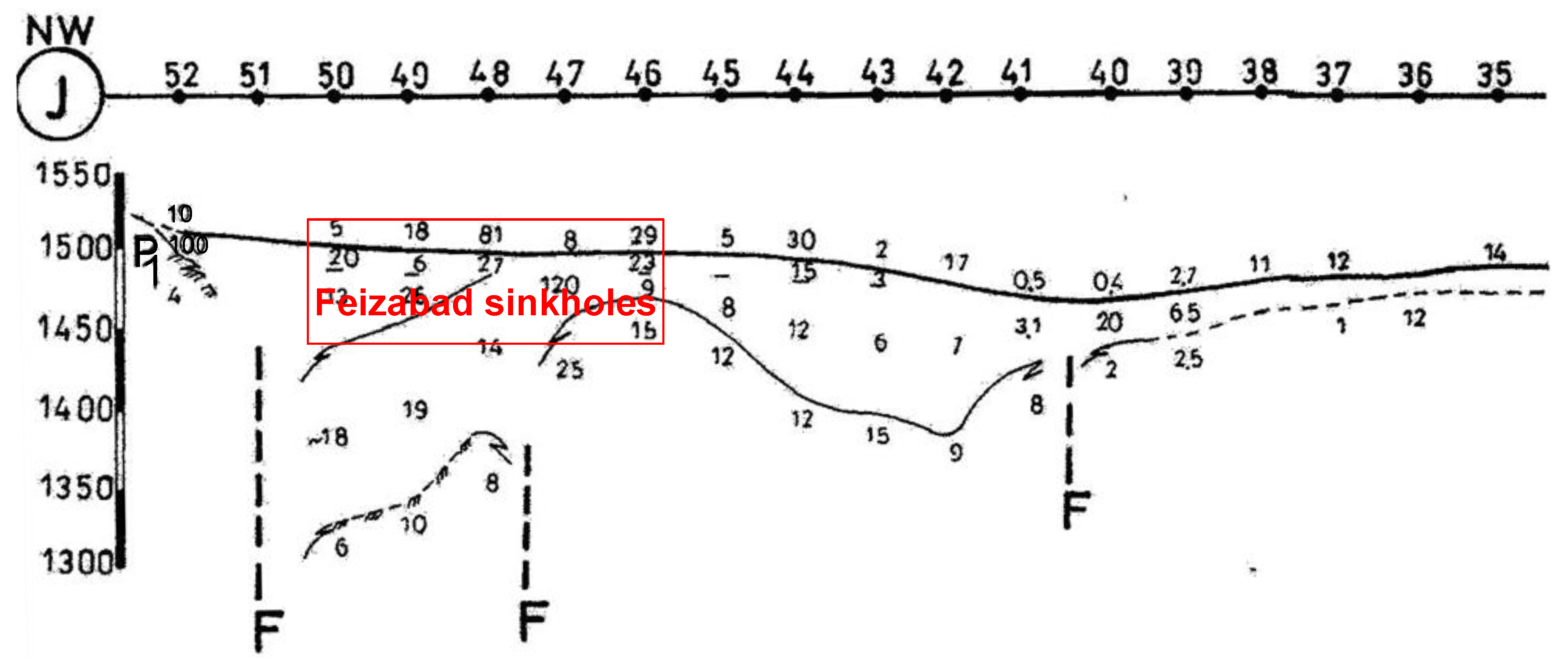
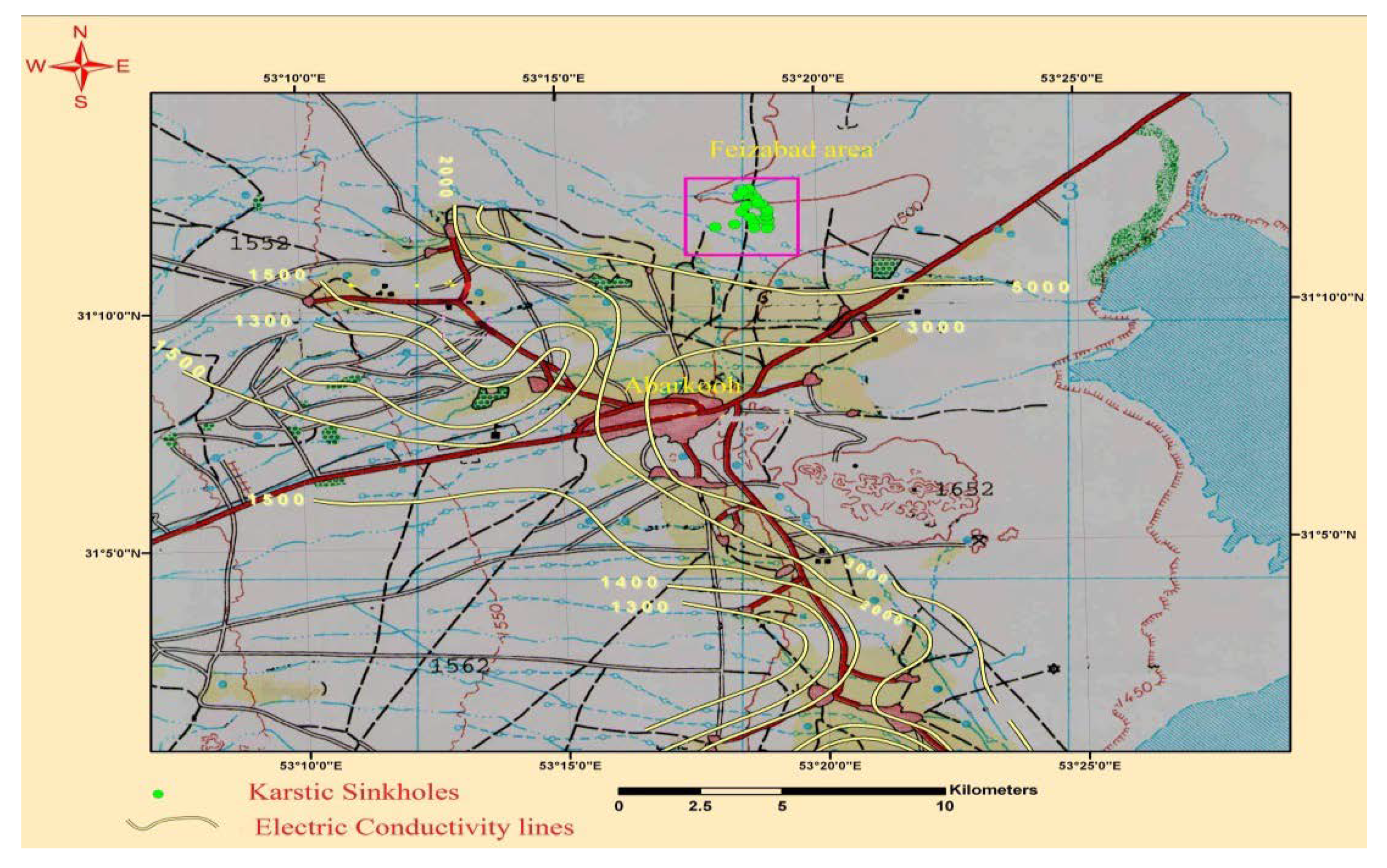
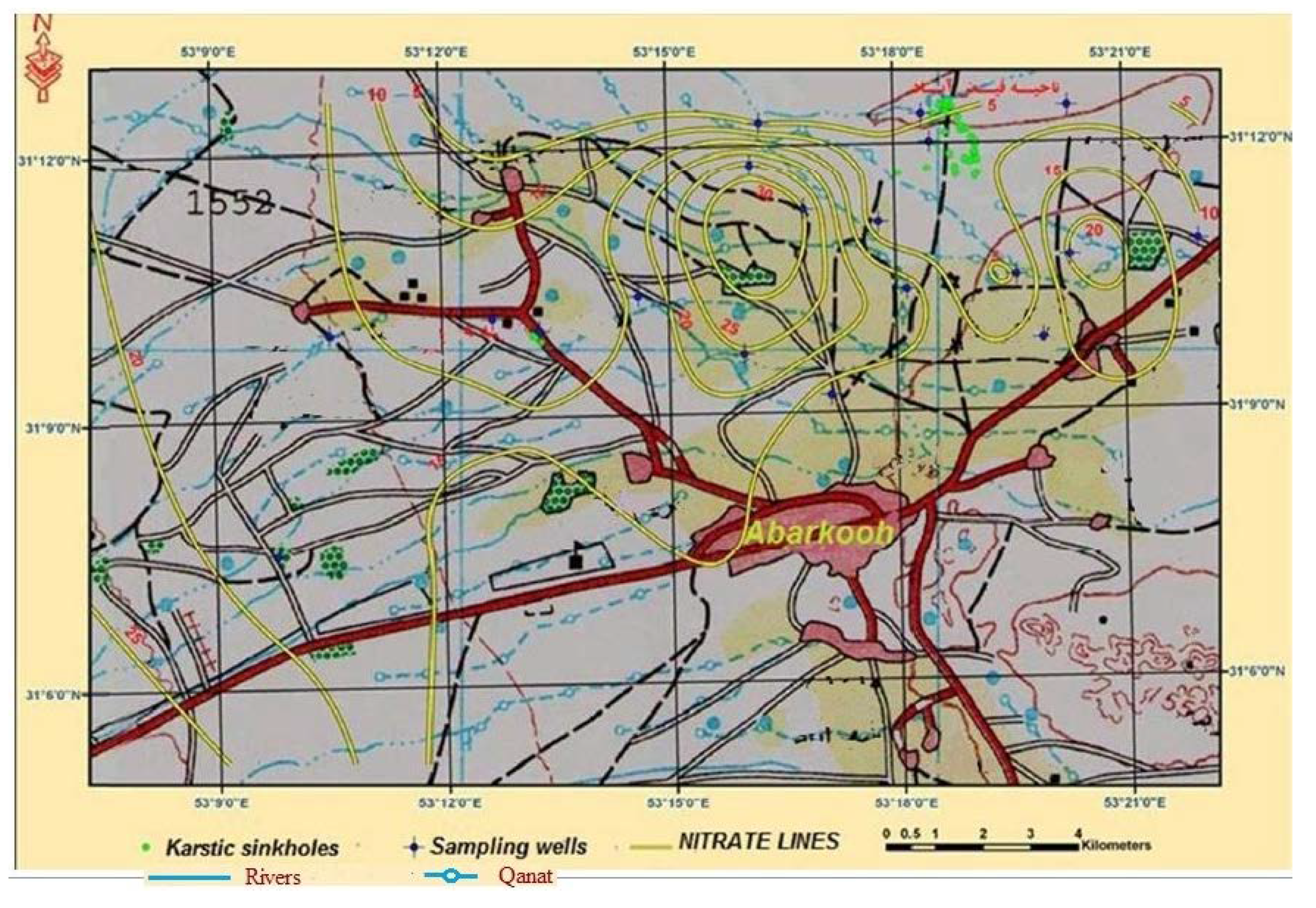
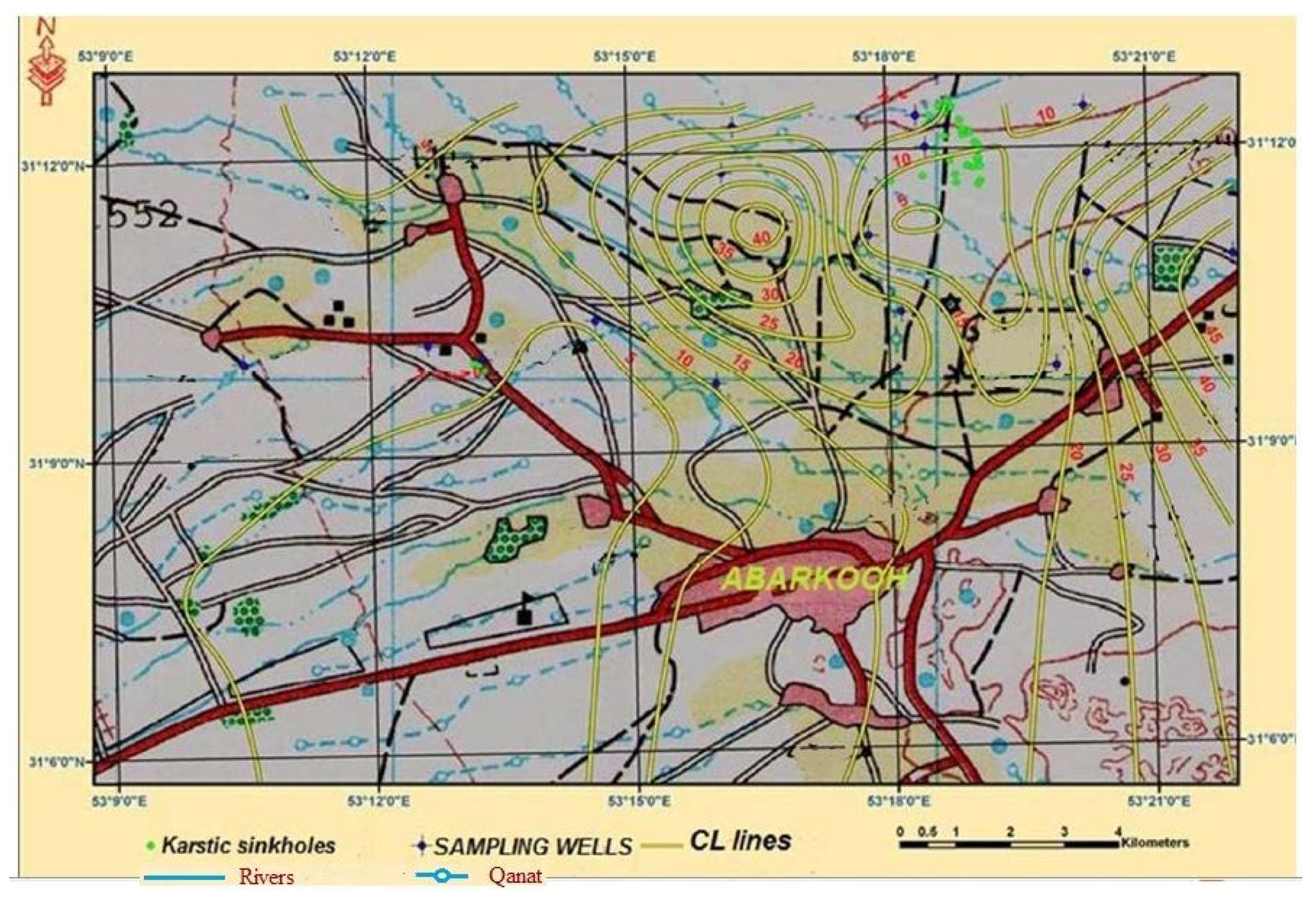
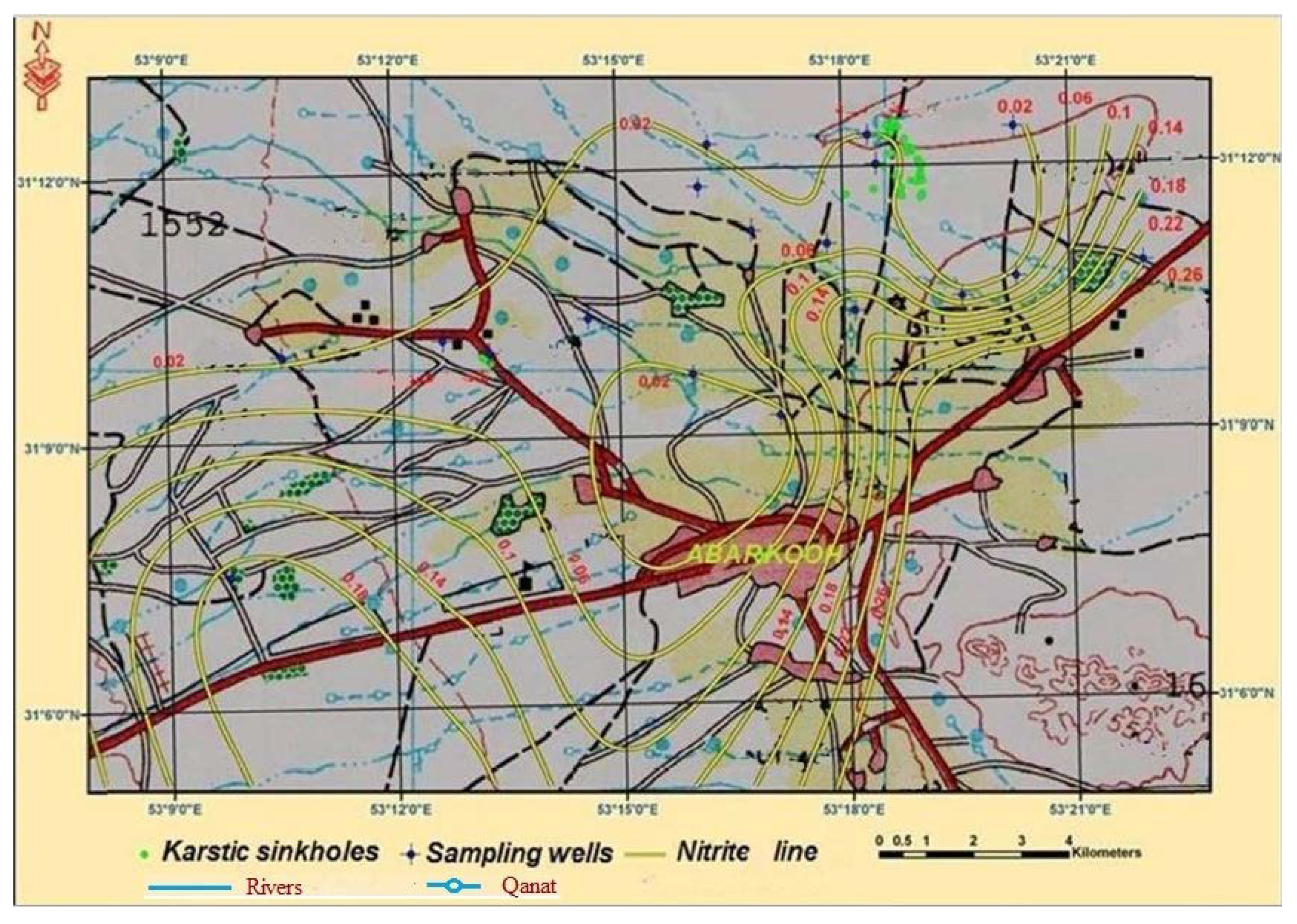
| X | Y | Well Name | mEq/L | ||||||||||||
|---|---|---|---|---|---|---|---|---|---|---|---|---|---|---|---|
| CO2 | HCO3 | CL | SO4 | NO3 | NO2 | SUM AN. | Ca | Mg | Na | K | SUM CAT. | ||||
| 1 | 701,619 | 3,441,155 | W81 | 0.4 | 2.9 | 8.75 | 7 | 0.001 | 0.49 | 19.54 | 5.00 | 5.00 | 10.63 | 0.06 | 20.69 |
| 2 | 706,294 | 3,445,451 | W82 | 0.4 | 2.3 | 5 | 4 | 0.004 | 0.29 | 11.99 | 3.00 | 2.00 | 7.60 | 0.04 | 12.64 |
| 3 | 707,344 | 3,450,046 | W83 | 0.4 | 2.3 | 5.95 | 2.5 | 0.000 | 0.25 | 11.40 | 2.50 | 2.30 | 7.16 | 0.04 | 12.00 |
| 4 | 710,733 | 3,450,391 | W84 | 0.4 | 2.3 | 6.1 | 3.5 | 0.001 | 0.22 | 12.52 | 2.30 | 2.90 | 7.60 | 0.05 | 12.85 |
| 5 | 711,721 | 3,450,145 | W85 | 0.4 | 2.3 | 6.35 | 3 | 0.001 | 0.22 | 12.27 | 2.50 | 2.30 | 9.77 | 0.05 | 14.62 |
| 6 | 713,794 | 3,450,871 | W86 | 0.4 | 2.8 | 6.25 | 7.5 | 0.001 | 0.26 | 17.21 | 4.20 | 3.40 | 8.02 | 0.04 | 15.66 |
| 7 | 716,024 | 3,449,697 | W87 | 0.4 | 2.2 | 10.75 | 5.5 | 0.000 | 0.40 | 19.25 | 3.60 | 5.20 | 11.06 | 0.04 | 19.90 |
| 8 | 717,857 | 3,448,835 | W88 | 0.2 | 1.8 | 15.15 | 5 | 0.000 | 0.21 | 22.36 | 4.60 | 7.40 | 13.62 | 0.07 | 25.69 |
| 9 | 719,433 | 3,451,052 | W89 | 0.2 | 1.7 | 22 | 8 | 0.004 | 0.27 | 32.17 | 5.50 | 7.00 | 20.40 | 0.07 | 32.97 |
| 10 | 721,704 | 3,451,367 | W810 | 0.6 | 2.7 | 9.5 | 2.25 | 0.001 | 0.09 | 15.14 | 3.00 | 2.00 | 10.42 | 0.07 | 15.49 |
| 11 | 722,819 | 3,451,785 | W811 | 0.4 | 2.8 | 31.75 | 10 | 0.001 | 0.33 | 45.28 | 5.50 | 9.50 | 28.64 | 0.09 | 43.73 |
| 12 | 722,748 | 3,454,874 | W812 | 0.8 | 3.1 | 8.85 | 2.5 | 0.000 | 0.12 | 15.37 | 2.70 | 3.30 | 9.98 | 0.08 | 16.06 |
| 13 | 719,862 | 3,454,095 | W813 | 0.6 | 2.7 | 11.5 | 2.5 | 0.001 | 0.13 | 17.43 | 3.00 | 4.50 | 13.00 | 0.07 | 20.57 |
| 14 | 719,683 | 3,454,674 | W814 | 0 | 3.4 | 16.5 | 2.95 | 0.000 | 0.05 | 22.90 | 4.40 | 6.10 | 13.75 | 0.07 | 24.32 |
| 15 | 716,311 | 3,454,463 | W815 | 0 | 4.7 | 13.65 | 4 | 0.000 | 0.08 | 22.43 | 5.00 | 6.00 | 12.17 | 0.07 | 23.24 |
| 16 | 716,114 | 3,453,602 | W816 | 0.4 | 3 | 31.45 | 12 | 0.001 | 0.42 | 47.27 | 5.20 | 8.30 | 32.98 | 0.14 | 46.62 |
| 17 | 717,250 | 3,452,895 | W817 | 0 | 3.5 | 40.25 | 13.75 | 0.001 | 0.48 | 57.98 | 8.20 | 9.90 | 42.60 | 0.15 | 60.85 |
| 18 | 725,508 | 3,452,123 | W818 | 0.8 | 3.1 | 48.25 | 5.5 | 0.001 | 0.17 | 57.83 | 3.20 | 4.80 | 50.34 | 0.20 | 58.54 |
| 19 | 722,267 | 3,450,067 | W819 | 0.6 | 2.7 | 17.25 | 5.5 | 0.006 | 0.21 | 26.26 | 4.00 | 5.00 | 16.05 | 0.07 | 25.12 |
| 20 | 718,828 | 3,452,441 | W820 | 0.6 | 2.6 | 7.75 | 2.75 | 0.001 | 0.12 | 13.82 | 2.50 | 2.50 | 10.45 | 0.09 | 15.54 |
| X | Y | Well Name | Mg/L | % | μm/cm | % | |||||
|---|---|---|---|---|---|---|---|---|---|---|---|
| T.D.S. | T.H | ALK | Na% | SAR | PH | EC | ERROR | ||||
| 1 | 701,619 | 3,441,155 | W81 | 1242.00 | 500.00 | 165.00 | 51.00 | 4.75 | 8.31 | 1864.00 | −2.85 |
| 2 | 706,294 | 3,445,451 | W82 | 782.00 | 250.00 | 135.00 | 60.00 | 4.81 | 8.41 | 1165.00 | −2.64 |
| 3 | 707,344 | 3,450,046 | W83 | 727.00 | 240.00 | 135.00 | 60.00 | 4.62 | 8.46 | 1166.00 | −2.55 |
| 4 | 710,733 | 3,450,391 | W84 | 749.00 | 260.00 | 135.00 | 59.00 | 4.71 | 8.46 | 1227.00 | −1.30 |
| 5 | 711,721 | 3,450,145 | W85 | 826.00 | 240.00 | 135.00 | 67.00 | 6.31 | 8.46 | 1177.00 | −8.73 |
| 6 | 713,794 | 3,450,871 | W86 | 1075.00 | 380.00 | 160.00 | 51.00 | 4.11 | 8.36 | 1562.00 | 4.71 |
| 7 | 716,024 | 3,449,697 | W87 | 1182.00 | 440.00 | 130.00 | 56.00 | 5.27 | 8.39 | 1872.00 | −1.67 |
| 8 | 717,857 | 3,448,835 | W88 | 1390.00 | 600.00 | 100.00 | 53.00 | 5.56 | 8.35 | 2252.00 | −6.92 |
| 9 | 719,433 | 3,451,052 | W89 | 1941.00 | 625.00 | 95.00 | 62.00 | 8.16 | 8.31 | 3145.00 | −1.23 |
| 10 | 721,704 | 3,451,367 | W810 | 954.00 | 250.00 | 165.00 | 67.00 | 6.59 | 8.56 | 1514.00 | −1.14 |
| 11 | 722,819 | 3,451,785 | W811 | 2676.00 | 750.00 | 160.00 | 65.00 | 10.46 | 8.33 | 4388.00 | 1.74 |
| 12 | 722,748 | 3,454,874 | W812 | 974.00 | 300.00 | 195.00 | 62.00 | 5.76 | 8.66 | 1480.00 | −2.21 |
| 13 | 719,862 | 3,454,095 | W813 | 1127.00 | 375.00 | 165.00 | 63.00 | 6.71 | 8.55 | 1747.00 | −8.27 |
| 14 | 719,683 | 3,454,674 | W814 | 1415.00 | 525.00 | 170.00 | 57.00 | 6.00 | 8.24 | 2343.00 | −3.00 |
| 15 | 716,311 | 3,454,463 | W815 | 1418.00 | 550.00 | 235.00 | 52.00 | 5.19 | 8.06 | 2232.00 | −1.77 |
| 16 | 716,114 | 3,453,602 | W816 | 2855.00 | 675.00 | 170.00 | 71.00 | 12.69 | 8.33 | 4686.00 | 0.69 |
| 17 | 717,250 | 3,452,895 | W817 | 3571.00 | 905.00 | 175.00 | 70.00 | 14.16 | 8.25 | 5727.00 | −2.41 |
| 18 | 725,508 | 3,452,123 | W818 | 3477.00 | 400.00 | 195.00 | 86.00 | 25.17 | 8.58 | 5824.00 | −0.61 |
| 19 | 722,267 | 3,450,067 | W819 | 1571.00 | 450.00 | 165.00 | 64.00 | 7.57 | 8.50 | 2578.00 | 2.22 |
| 20 | 718,828 | 3,452,441 | W820 | 908.00 | 250.00 | 160.00 | 67.00 | 6.61 | 8.57 | 1336.00 | −5.86 |
© 2020 by the authors. Licensee MDPI, Basel, Switzerland. This article is an open access article distributed under the terms and conditions of the Creative Commons Attribution (CC BY) license (http://creativecommons.org/licenses/by/4.0/).
Share and Cite
Soldo, B.; Mahmoudi Sivand, S.; Afrasiabian, A.; Đurin, B. Effect of Sinkholes on Groundwater Resources in Arid and Semi-Arid Karst Area in Abarkooh, Iran. Environments 2020, 7, 26. https://doi.org/10.3390/environments7040026
Soldo B, Mahmoudi Sivand S, Afrasiabian A, Đurin B. Effect of Sinkholes on Groundwater Resources in Arid and Semi-Arid Karst Area in Abarkooh, Iran. Environments. 2020; 7(4):26. https://doi.org/10.3390/environments7040026
Chicago/Turabian StyleSoldo, Božo, Siamak Mahmoudi Sivand, Ardalan Afrasiabian, and Bojan Đurin. 2020. "Effect of Sinkholes on Groundwater Resources in Arid and Semi-Arid Karst Area in Abarkooh, Iran" Environments 7, no. 4: 26. https://doi.org/10.3390/environments7040026
APA StyleSoldo, B., Mahmoudi Sivand, S., Afrasiabian, A., & Đurin, B. (2020). Effect of Sinkholes on Groundwater Resources in Arid and Semi-Arid Karst Area in Abarkooh, Iran. Environments, 7(4), 26. https://doi.org/10.3390/environments7040026






